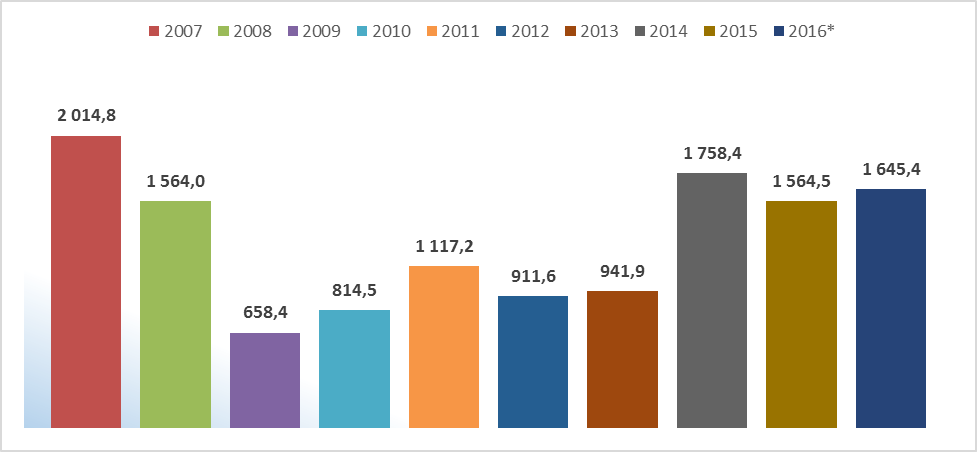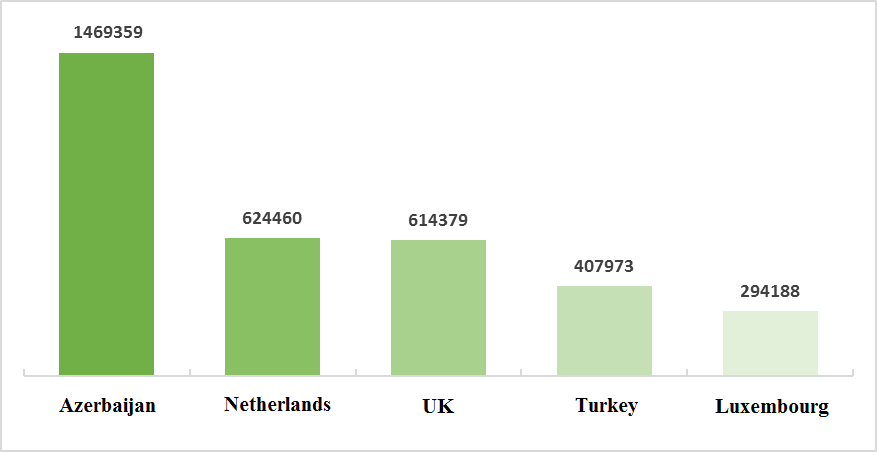On 9 March 2017, a member of the European Georgia, Sergi Kapanadze, in his speech before the Parliament of Georgia, stated: "In 2015, when finance sector supervision functions were separated from the National Bank of Georgia, the amount of investments dropped as compared to 2014 – in the third quarter of 2015 investments dropped by 250 million and in the fourth quarter of 2015 by 200 million. In 2016 investments grew by 90 million, but in the third and fourth quarters of 2016, the amount of investments was 20-20 million less as compared to the same periods of 2015."
FactCheck verified the accuracy of Sergi Kapanadze’s statement based on data of National Statistics Office of Georgia.
In September 2015, the Organic Law on the National Bank of Georgia was amended. According to the amendments the National Bank of Georgia was stripped of the finance sector supervision function. An independent monitoring entity was supposed to assume supervisory duties. However, on 22 October 2015, pending the final verdict, Plenum of the Constitutional Court of Georgia suspended the enforcement of those controversial norms which decreed the operation of Supervisory Agency. Therefore, before the final verdict, National Bank of Georgia was charged again to carry out finance sector supervision function. As stated by Sergi Kapanadze, the amount of foreign direct investments in Georgia dropped precisely at that time.
The dynamic of foreign direct investments throughout 2006-2016 are characterized with periodic fluctuation. Of note is that the highest amount of investments in Georgia (USD 2,014) was registered in 2007.
Since 2012, up until 2015, the amount of investments per annum has been increasing and in 2014 it reached USD 1,758 million. The amount of foreign direct investments in 2015 did indeed drop as compared to 2014 by USD 194 million. However, the volume of investments in 2016 reached USD 1,645 and exceeded investment volume registered in 2015
Graph 1: Dynamic of Foreign Direct Investments in Georgia (USD million)
 Source: National Statistics Office of Georgia (*2016 – preliminary data)
In regard to data by quarters in 2014-2016, the highest amount of investments in the first quarter was registered in 2016, in the second quarter in 2015 and in the third and fourth quarters in 2014.
Graph 2: Dynamic of Foreign Direct Investments in Georgia by Quarters (USD million)
Source: National Statistics Office of Georgia (*2016 – preliminary data)
In regard to data by quarters in 2014-2016, the highest amount of investments in the first quarter was registered in 2016, in the second quarter in 2015 and in the third and fourth quarters in 2014.
Graph 2: Dynamic of Foreign Direct Investments in Georgia by Quarters (USD million)
 Source: National Statistics Office of Georgia
Additionally, in 2014, 2015 and 2016 the largest amount of investments was made from Azerbaijan. Netherlands, UK, Turkey and Luxembourg are also among Georgia’s top investors. Of further note is that in the aforementioned given period the amount of total investments made by Commonwealth of Independent State (CIS) countries are twice as less as compared to the total amount of investments made by EU member states.
Graph 3: The Amount of Investments of Georgia in the period of 2014-2015-2016 by Countries (USD Million)
Source: National Statistics Office of Georgia
Additionally, in 2014, 2015 and 2016 the largest amount of investments was made from Azerbaijan. Netherlands, UK, Turkey and Luxembourg are also among Georgia’s top investors. Of further note is that in the aforementioned given period the amount of total investments made by Commonwealth of Independent State (CIS) countries are twice as less as compared to the total amount of investments made by EU member states.
Graph 3: The Amount of Investments of Georgia in the period of 2014-2015-2016 by Countries (USD Million)
 Source: National Statistics Office of Georgia
Conclusion
As stated by Sergi Kapanadze, in the third and fourth quarters of 2015, after stripping off the National Bank of Georgia the supervisory functions, the amount of investments in the country has indeed decreased. Specifically, investments dropped by approximately USD 250 million in the third quarter and by USD 200 million in the fourth quarter of 2015 as compared to the same periods of 2014. Total annual amount of investments in 2016 (final figures are still to be published) exceed the amount of investments registered in 2015 by USD 90 million. However, the amount of investments in the third and fourth quarters of 2016 is less as compared to the figures of the same period of 2015. Of note is that the difference is USD 20 million in total and not USD 20 million in each quarter.
Political pressure (and this pressure was officially noted by the international financial organizations) applied against the National Bank of Georgia, can really be considered as one of the reasons behind the declining investments in 2015. However, growth/drop of investments are determined by much complex factors and it is not appropriate to explain the changes in the volume of investments solely by separation of bank supervision function from the National Bank of Georgia.
FactCheck concludes that Sergi Kapanadze’s statement is MOSTLY TRUE.
Source: National Statistics Office of Georgia
Conclusion
As stated by Sergi Kapanadze, in the third and fourth quarters of 2015, after stripping off the National Bank of Georgia the supervisory functions, the amount of investments in the country has indeed decreased. Specifically, investments dropped by approximately USD 250 million in the third quarter and by USD 200 million in the fourth quarter of 2015 as compared to the same periods of 2014. Total annual amount of investments in 2016 (final figures are still to be published) exceed the amount of investments registered in 2015 by USD 90 million. However, the amount of investments in the third and fourth quarters of 2016 is less as compared to the figures of the same period of 2015. Of note is that the difference is USD 20 million in total and not USD 20 million in each quarter.
Political pressure (and this pressure was officially noted by the international financial organizations) applied against the National Bank of Georgia, can really be considered as one of the reasons behind the declining investments in 2015. However, growth/drop of investments are determined by much complex factors and it is not appropriate to explain the changes in the volume of investments solely by separation of bank supervision function from the National Bank of Georgia.
FactCheck concludes that Sergi Kapanadze’s statement is MOSTLY TRUE.
 Source: National Statistics Office of Georgia (*2016 – preliminary data)
In regard to data by quarters in 2014-2016, the highest amount of investments in the first quarter was registered in 2016, in the second quarter in 2015 and in the third and fourth quarters in 2014.
Graph 2: Dynamic of Foreign Direct Investments in Georgia by Quarters (USD million)
Source: National Statistics Office of Georgia (*2016 – preliminary data)
In regard to data by quarters in 2014-2016, the highest amount of investments in the first quarter was registered in 2016, in the second quarter in 2015 and in the third and fourth quarters in 2014.
Graph 2: Dynamic of Foreign Direct Investments in Georgia by Quarters (USD million)
 Source: National Statistics Office of Georgia
Additionally, in 2014, 2015 and 2016 the largest amount of investments was made from Azerbaijan. Netherlands, UK, Turkey and Luxembourg are also among Georgia’s top investors. Of further note is that in the aforementioned given period the amount of total investments made by Commonwealth of Independent State (CIS) countries are twice as less as compared to the total amount of investments made by EU member states.
Graph 3: The Amount of Investments of Georgia in the period of 2014-2015-2016 by Countries (USD Million)
Source: National Statistics Office of Georgia
Additionally, in 2014, 2015 and 2016 the largest amount of investments was made from Azerbaijan. Netherlands, UK, Turkey and Luxembourg are also among Georgia’s top investors. Of further note is that in the aforementioned given period the amount of total investments made by Commonwealth of Independent State (CIS) countries are twice as less as compared to the total amount of investments made by EU member states.
Graph 3: The Amount of Investments of Georgia in the period of 2014-2015-2016 by Countries (USD Million)
 Source: National Statistics Office of Georgia
Conclusion
As stated by Sergi Kapanadze, in the third and fourth quarters of 2015, after stripping off the National Bank of Georgia the supervisory functions, the amount of investments in the country has indeed decreased. Specifically, investments dropped by approximately USD 250 million in the third quarter and by USD 200 million in the fourth quarter of 2015 as compared to the same periods of 2014. Total annual amount of investments in 2016 (final figures are still to be published) exceed the amount of investments registered in 2015 by USD 90 million. However, the amount of investments in the third and fourth quarters of 2016 is less as compared to the figures of the same period of 2015. Of note is that the difference is USD 20 million in total and not USD 20 million in each quarter.
Political pressure (and this pressure was officially noted by the international financial organizations) applied against the National Bank of Georgia, can really be considered as one of the reasons behind the declining investments in 2015. However, growth/drop of investments are determined by much complex factors and it is not appropriate to explain the changes in the volume of investments solely by separation of bank supervision function from the National Bank of Georgia.
FactCheck concludes that Sergi Kapanadze’s statement is MOSTLY TRUE.
Source: National Statistics Office of Georgia
Conclusion
As stated by Sergi Kapanadze, in the third and fourth quarters of 2015, after stripping off the National Bank of Georgia the supervisory functions, the amount of investments in the country has indeed decreased. Specifically, investments dropped by approximately USD 250 million in the third quarter and by USD 200 million in the fourth quarter of 2015 as compared to the same periods of 2014. Total annual amount of investments in 2016 (final figures are still to be published) exceed the amount of investments registered in 2015 by USD 90 million. However, the amount of investments in the third and fourth quarters of 2016 is less as compared to the figures of the same period of 2015. Of note is that the difference is USD 20 million in total and not USD 20 million in each quarter.
Political pressure (and this pressure was officially noted by the international financial organizations) applied against the National Bank of Georgia, can really be considered as one of the reasons behind the declining investments in 2015. However, growth/drop of investments are determined by much complex factors and it is not appropriate to explain the changes in the volume of investments solely by separation of bank supervision function from the National Bank of Georgia.
FactCheck concludes that Sergi Kapanadze’s statement is MOSTLY TRUE.
Tags:








